Butterfly Stretch / Internal Rotator Stretch
Duration :1 Minute
Instructions:
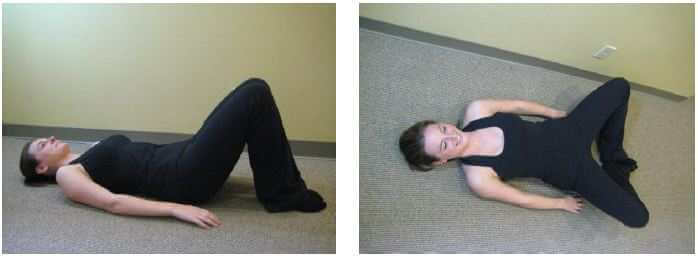
- Lie supine, holding your feet together.
- Allow the weight of your knees to fall apart from one another.
- You should feel the stretch in your groin and hips.
- Hold the position for a minimum of 10 seconds; stop if you feel pain or dizziness.
- Repeat a minimum of 3 times, up to 10 times, every day.
STRETCHING OCCURS OVER TIME. DOING ONE STRETCH ONCE A MONTH WON’T DO THE JOB!
External Rotator Stretch, II
Duration :2 Minutes
Instructions:
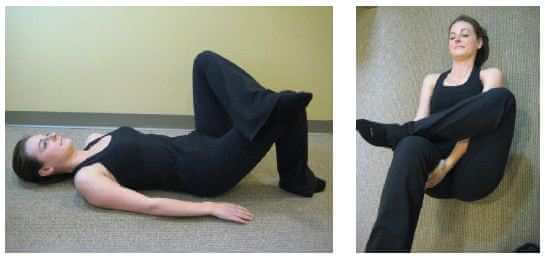
- Begin in a supine position.
- Cross the leg of the hip you wish to stretch over top of the other.
- Reach up around the “under” leg, and pull towards your chest. (In the picture the model is stretching her left side)
- You should feel the stretch in the center of your “cheek”.
- Hold the position for a minimum of 10 seconds, more reasonably 20; stop if you feel pain or dizziness.
- Repeat a minimum of 3 times, up to 10 times, every day.
STRETCHING OCCURS OVER TIME. DOING ONE STRETCH ONCE A MONTH WON’T DO THE JOB!
Basic Hamstring Stretch
Duration :1-3 Minutes
Instructions:
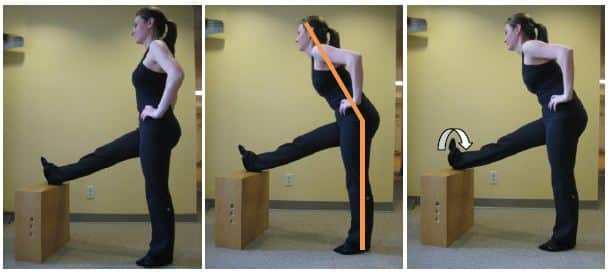
- This is one of the most important stretches we teach. Begin by placing your heel on an object approximately 18” high, and stand as erectly as possible.
- Extend your low back, tilting your pelvis forward, and bend forward from the hips, maintaining the curve of your low back.
- If you are experiencing low back pain, support your back by placing your hands on your leg for support.
- For added emphasis, tilt your toes back toward you. You should feel the stretch in the back of your leg.
- Hold for 10-15 seconds.
- Repeat often, 8-10 times, every day.
Foam Roller Stretch
Duration :1-3 Minutes
Instructions:

- Begin by lying your upper back on the roller, fingers interlaced behind your head.
- Lift your pelvis slightly off the floor, and walk your body up the roller to approximately the “bra strap” level. (see the picture) You should feel the stretch in the center of your back.
- To control the depth of the stretch, use your arms to either lift for less (image 2) or lower for more (image 3).
- Repeat often, every day.
Cat and Cow Exercise
Duration : 2-3 Minutes
Instructions:

This is a great exercise for patients who suffer from lumbar disc injuries… it helps most in the morning, when the discs have the most water in them.
- Get on all fours, knees behind the hips.
- Allow your belly to drop out to the floor, and look up to the ceiling. This is EXTENSION, something (almost) every lumbar disc loves.
- Hold this position for 30 to 40 seconds. Breathe using your belly during this time.
- Then, begin to arch your back.
- Hold this position for only one to two seconds.
- Repeat this for 2-3 minutes.
- For acute disc pain, performing a variation of this in the shower, with hot water on the low back, is also acceptable.
- With a lumbar disc injury, avoid bending and rotating at all costs!
Remember, the downward motion Picture (#2)is the important one. Focus on relaxing into this position most.
Ball and Foam Roller Pec Stretch
Duration :1 Minute
Instructions:
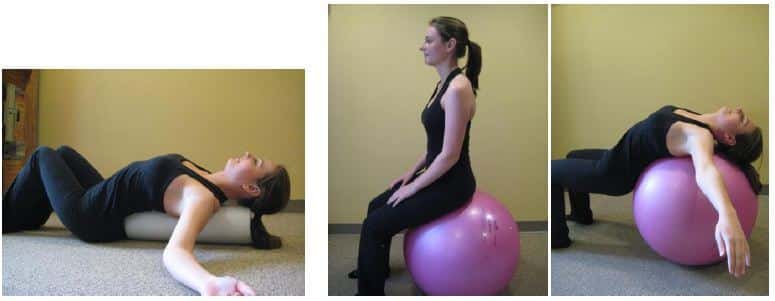
ROLLER:
- Begin by lying longitudinally on the roller.
- Allow your arms to fall away from your body.
- Hold this position for 30 seconds.
BALL:
- Sitting on the ball, walk your feet forward, lying back on the ball as you do.
- Allow your arms to fall by the side, hold this position.
- Repeat often, every day.
STRETCHING TAKES TIME. DOING AN EXERCISE ONCE A MONTH DOES NOT WORK!
Scalene Stretches
Duration :1 Minute
Instructions:
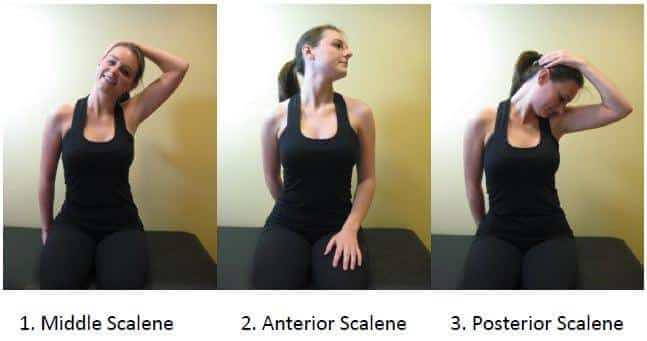
- There are 3 scalene muscles in the neck; the most common stretches we recommend are the middle and anterior for stretching, NOT the posterior.
- Sit as straight as possible, and place the hand of the side to be stretched under that buttock.
- For the middle muscle, pull your head away from the hand you are sitting on for 10 seconds.
- For the anterior stretch, put the hand behind you, and turn the head away from it.
- Then tilt your head back. (Stop if you feel any signs of dizziness or feel like you are about to faint!! )
- If the doctor gave you posterior scalene stretches, put on deodorant, sit on your hand again, and pull your head forward and into your armpit.
- hold all stretches a minimum of 10 seconds.
Middle Scalene Stretch
Duration :1 Minute
Instructions:
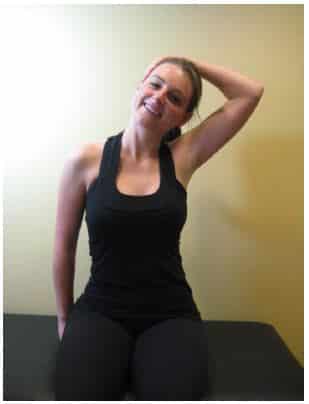
- Sitting erectly, sit on the hand of the side you desire to stretch.
- Reach over your head, and pull gently, in a rainbow like fashion, away from the hand you are sitting on. This stretch is especially important for patients with Thoracic Outlet Syndrome, and should be done in conjunction with the Anterior Scalene Stretch, also accessible through our website.
- Hold the position for a minimum of 10 seconds; stop if you feel pain or dizziness.
STRETCHING OCCURS OVER TIME. DOING ONE STRETCH ONCE A MONTH WON’T DO THE JOB!
Hamstring Stretching Self Help
Duration :1 Minute
Instructions:
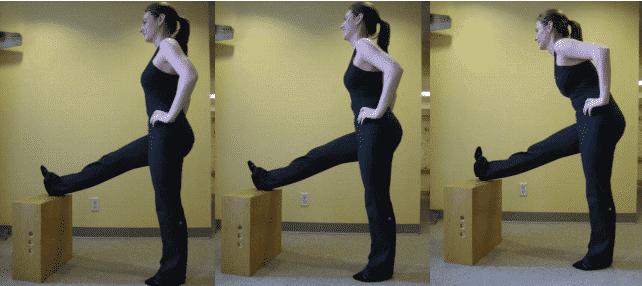
- Find a stable object approximately 18” off the ground.
- Place your heel of the side you are stretching on it, standing as erectly as possible.
- Extend your belly, and imagine an axis through your hips, and bend forward.
- Gently stretch your hamstrings muscles; if you feel like you have to bend more than you would like, flex your foot back towards you.
- Hold the stretch for approximately 8-10 seconds. Repeat 3-5x , every hour.
STRETCHING OCCURS OVER TIME. DOING ONE STRETCH ONCE A MONTH WON’T DO THE JOB!
Three dimensional stretching... part one.
Too often we think about muscles as being only one dimensional and working in only one direction. We are taught the origins and insertions of them, their actions and innervations, but we lose sight of what they actually are… muscles are not strings that tighten, but instead able to move in three dimensions. When we stretch a muscle group in only one plane, we forget that there is an x, a y and z axis that are left unstretched. Is it any wonder why we can’t see any changes with the stretches we give our patients?
So let’s start with the muscles themselves.Muscles are comprised of myofilaments, and are ordered into strands called fascicles. (fascicles are derived from Latin faces, which was a bundle of iron rods, bound by ribbon, used as a sign of absolute power, and can still be seen outside US government buildings, and the rise of the word fascist)
The point of this entry is not to wow you with trivia about muscles, but instead to get you to think about muscles in a different way: Simply put, muscle tissue is not singly dimensional, and therefore shouldn’t be stretched in only one plane.
This is especially true with muscles that have the suffix “-ceps” in them… triceps, biceps, quadriceps… their very name tells you that there is more than one head attachment which requires a different plane to work in. This is also the case where there is a “major” or “minor” ending, as well.
When showing stretching to my patients, I often describe these planes as around each axis, where each plane needs to be stretched around.
Perhaps nowhere in the body is the concept of 3 dimensional muscles better found than that of the iliopsoas muscles, which most people refer to simply as the “psoas”. Nothing could be farther from the truth.
The iliacus inserts around the entire rim of the pelvis, forming a nearly 90 degree angle from one insertion point to another! The psoas major and minor attach to the lumbar vertebrae, and to the discs at each level, with each head requiring a different plane of stretching to address altogether.
This stretch is the most important first point of addressing lumbar stenosis, outlined on the website.
